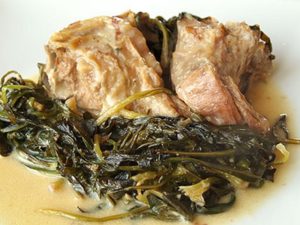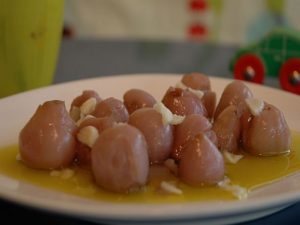The Cretan food is the pinnacle of Mediterranean cooking. Cretan cuisine is renowned both in Greece and internationally for its unique ingredients and flavours. Based on simple techniques, it’s the variety of local produce that distinguishes the dishes: mountain herbs and greens, bulbs, unique cheeses, fresh fish, the famous Cretan oil, and raki a bracing grape brandy.
The famous Cretan dishes, cooked in front of the guest while the guest is being encouraged to participate in the cooking and prepare the dishes together with our chef and cooking team. The chef usually decides which dishes to show, however we are welcoming our guest to request specific dishes they wish to learn. Finally the guests consume their creation – a five course lunch or dinner includes appetizers, salad, first course, main course and desert. The duration of the lesson and the dining is approximately 3 – 5 hrs (combining cooking and eating time). The guests also take with them written recipes and tips!
Don’t leave Crete without trying…
Cretan Cheeses
It seems that almost every Cretan village has its own signature cheese. They are usually made from sheep or goat’s milk, or a combination of both and each cheese variety has its local interpretation. Of the legion of delicious cheeses, look for graviera, a harder cheese that’s sweeter when new, but nutty and flavourful after aging. Soft, creamy cheeses, abound like pichtogalo Chanion, which has AOC protection, or myzithra, a young whey cheese with a lovely mild taste.

Dakos
The ever-popular dakos is known by regional names throughout Crete…some call itkoukouvagia (literally ‘owl’); in the east they call it kouloukopsomo (literally ‘puppy bread’). What is it? A fantastic Greek meze or salad reminiscent of bruschetta, but based on barley rusks or paximadi, not on bread. The rusks are lightly soaked in water or olive oil to soften them, and then they are topped with grated fresh tomato and myzithra, the creamy sheep or goat’s milk cheese. They are then drizzled with Cretan virgin olive oil and dusted with salt, oregano, pepper.

Fried snails (Chochlioi boubouristi)
It’s not only the French who treat snails as a delicacy. In fact, snails have been eaten for millennia. In the Cretan dialect chochlios means snail, and in this dish they are fried with flour and hot olive oil in a pan, then doused with wine (or vinegar), and voila, ready to serve. Some like to add a dash of wild rosemary. Locally, women collect the snails by hand and the creatures are cooked up live.

Cretan Cheese Pies (Kaltsounia)
These small pies may look like the multitude of cheese pies you’ll encounter throughout Greece, but these are unique! To start, handmade pastry dough is a must, usually shaped into tiny cups. The fillings vary – every region and often each household has its favourite. They tend toward the sweet, and count on any number of those luscious Cretan cheeses, like myzithra or malaka, but not feta. We like the ones that incorporate a hint of rosewater. The final touch is Cretan honey on the top, making the pies a heady combination of sweet and savoury.

Lamb with stamnagathi
As with most Greek foods, Cretans have their own take on lamb. Their version incorporatesstamnagathi, a wild green that has become trendy of late, and features on many top-end restaurant menus. The Cretan lamb is sautéed in hot olive oil and oregano accompanied with the stamnagathi green and the well-known avgolemono (egg and lemon-based) sauce, or, more simply, a squeeze of fresh lemon.

Gamopilafo
As the name hints (gamos means ‘wedding’ in Greek) this rice dish is offered at traditional Cretan weddings. These days you will find it not only when the whole village is celebrating nuptials in the town square, but also in many Cretan tavernas. Like a deluxe risotto, it is prepared in a rich meat broth that you make from a lengthy simmering of goat, lamb or rooster. Then you incorporate a dash of lemon juice and liberal amounts of stakovoutiro – this is a butter created from the creamy skin that forms on the top of boiled fresh goat’s milk and is turned into a roux. It is the crème de la crème!

Grilled Lamb (Antikrtisto)
Part of the magic of Cretan food are the grilled lamb. The lamb is placed on a special construction around the fire and slowly cooked from the fire of the wood that is placed at the centre of the construction.

Mountain Bulbs (Askordoulakous)
Part of the magic of Cretan food are the ingredients gathered from hillsides and around villages. Askordoulakous are the bulbs of a wild green, and Cretans gather bulbs and eat them as a fresh salad, dressed with oil and vinegar or lemon. They also pickle them, or stew them with local olive oil, vinegar and flour. The delicate white blossoms of the green are also edible, simply boiled or used in other dishes.

Smoked Pork (Hirina apakia)
Not an easy one to recreate outside of Greece, this dish of succulent smoked pork, is made in a multi-day process. First, strips of pork are marinated in vinegar for several days. Then a fire is made using local herbs – sage, bay, rosemary – and the meat is hung above it to smoke. The smoke is continuously stoked to keep the herby aroma infusing the meat. The final product tastes of the fresh herbs and can be served later, cold, in thin slices.

Sfakia pies (Sfakianes pites)
These yummy pies hale from southern Crete, from a mountainous coastal region called Sfakia. At a glance, these treats look like pancakes, but beyond the flour, the dough contains, local olive oil, and the infamous Cretan liquor, raki. Then, any number of the various Cretan fresh, soft, white goat or sheep’s milk cheeses like myzithra or pichtogalo Chanion are incorporated into the centre of the pie. Fried with only a light brushing of olive oil, they are eaten with a drizzling of thyme or heather honey.

